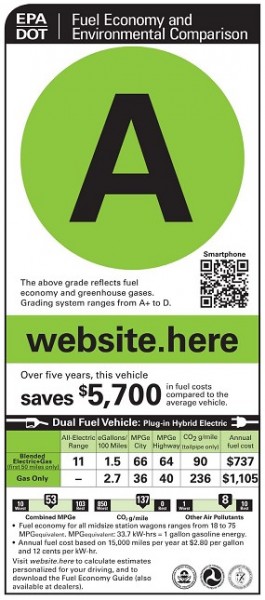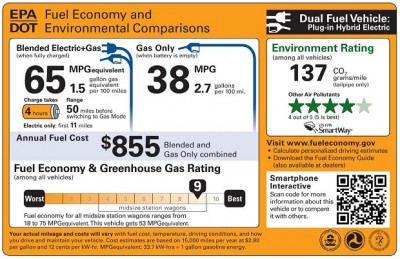Sep
7
New Fuel Efficiency Labels for New Cars
September 7, 2010 | 3 Comments
Last Monday the Environmental Protection Agency and Department of Transportation proposed a fuel economy label overhaul to measure how electric and alternative fuel vehicles stack up against gasoline and diesel passenger vehicles.
The officials expect the ‘proposed’ new labels to be finalized early next year and used in 2012 model year cars. The published labels will be available for public comment for 60 days starting last week.
The new label is mandated by the 2007 energy law and includes the same old information on city and highway miles per gallon and estimated driving costs based on 15,000 miles a year.
This writer has thought about the offer to comment over for a week, and concluded its best to share the over riding thoughts with the loyal readers. In a few days the thoughts ran to a posting maybe 10,000 words long – so this is a very truncated version.
Here is a link to the 19-page pdf with the labels proposed as seen in the Federal Register.
For one label proposal, the bureaucrats would add a letter grade summing up a vehicle’s energy efficiency and greenhouse gas emissions. Under the second label proposal, current stickers would be expanded to include comparison of various vehicles’ fuel economy and emissions. There is a third proposal as discussed below.
What stands out is the gallons of fuel per 100 miles measure on the first proposed label (Starts on pdf page 2). Mathematical reasoning has finally hit D.C. The full electric vehicle version has a spot for kWhrs per 100 miles. The savings claims are going to vary hugely across the price of gas, ethanol blends and electric rates. But it’s a start.
The consideration for leveling the measure across a diverse range of vehicles is a concept of “MPGequivalent” at 33.7 kWhrs per gallon of gasoline. The gasoline value is set at $2.80 per gallon. That’s where the math simplifies. One can run one’s own numbers with the data provided and adjust for local market prices.
Lots of comment has been made over the past week over the letter grades such a children’s school grades of ‘A’ down to ’D’. This writer has no particular argument about using up paper and window space for a very quick rating – everything sold will be subjected to the same assumptions – simply because most people aren’t going to get into the fine details.
But the outstanding thing is there are different labels for different power unit types. From pure electric recharged by the grid to hybrids and on more to straight gasoline and diesel engines the big main groups are singled out for fairness. And fair it has to be as the needs of buyers are going to be every bit and more diverse than the range of labels. If we’re not careful a bit of admiration might show for a set of labels that actually include useful information designed by government personnel.
The second label proposal (Starts on pdf page 10) is going to look more familiar. It emblazons the familiar miles per gallon combined with breakouts for city and highway mileage with the annual fuel cost for fueled vehicles. The electric vehicle will again get the MPGequivalent thing with a quite useful notation of time to full battery charge and anticipated range.
The hybrids get a much more busy label with the all electric and the gas or diesel only information. The proposed label understandably skips over the longer trips with say 75% electric and 25% fueled propulsion, but does outline the values when running only electric and only fuel.
The second label doesn’t get a letter grade space – to much relief.
The government’s pdf file of the proposed labels includes a third option at pdf page 16 that most writers seem to overlook. The third option uses a third of the space to point out the environmental rating with a star field with’ better’ getting more colored in stars.
The third label for electric vehicles offers a larger charge information space with full charge time and an anticipated range. A very busy hybrid label set covers the hybrids.
Some pretty calm and thoughtful folks thought all this through. If this writer were deciding, the second label choice would be the prime candidate for despoiling the gorgeous model’s window on the showroom floor.
But factually this writer and most of you are the cerebral types looking for more complete information. Label choice one, the thinnest and desultory one fails us and might positively affect the average disinterested buyer.
Label three is marginally better, but wastes space and is a silly exercise in making an environmental point. Everyone gets the fact that better efficiency is going to consume fewer resources and dump less waste. It’s a genuine political statement, no one wants to dump into the air, so whipping on buyers seems to be seizing a forced opportunity and cheating buyers out of useful data.
That would make label 2 the best choice and even better if a spot for gallons or kWhrs per 100 miles and the five year savings compared to the average from label one substitutes the space for the environmental junk.
That’s this writer’s take on the label that will come proposed or not. It could be a straight information piece with great data and a convenient means to make comparisons. Lose the environment greenhouse gas and pollutants political statement, stay on course and do the public service and the label change might be worth our time for a close inspection and thought.
You’re free to use any thoughts here for yourself if you choose to comment.
Comments
3 Comments so far





As I mentioned one month ago about a phenomenon linking energy efficiency with various factors including the idea of austerity, I would like to write this comment on that phenomenon – this time it is about motor vehicle efficiency.
What if the best choice has for a particular motor vehicle well suited to the technical and philosopical aspects of what I call “discriminatory fuel efficiency ratings” not just in the U.S. but also around the globe, especially in developed countries? No one knows how do they implement in different nations, I say. Do such policies even apply to developing countries as well? Too bad those measures will cost much to both implement and enforce in the name of global environmentalism!
Why did even simple measures can result in big consequences because of what U.K.-based economics journalist Daniel Ben Ami called “growth skepticism”? It is time to understand how growth skepticism is justified for the misbegotten purpose of promoting the ideology of environmentalism as another idea of austerity.
Do motor vehicles have any current or future techologies useful mainly for mileage reasons? Better understand what are people referring to while trying out on those devices.
More on that later.
Good information, you write it very clean. I am very lucky to get these tips from you.
I would like to add on a comment write-up that motor vehicle fuel efficiency remains a philosopical and technical phenomenon that needs to discussed on its own merits, and to look into other factors that may link to what Daniel Ben-Ami has called “growth skepticism”.
Please follow the steps in investigating the vehicle’s efficiency-to-weight ratio:
1) Choose the engine and powertrain layouts to test the vehicle;
2) Find out how a particular motor vehicle works and see for yourself;
3) Check the design features of a car or a commercial vehicle;
4) Reveal the vehicle weight which is important to understand the ratio;
5) Check the tire and wheel size (remember: there should be used for reference only);
6) Find out on how safety, fuel consumption, performance, and other factors that come into consideration;
7) Test the vehicle then rate it to the highiest detail possible; and
8) Please reveal how much it would cost a particular motor vehicle.
Remember to do these and make better use of it, to ensure ther are no errors in reporting the motor vehicle’s efficiency-to-weight ratio – and it will make a difference in the transportation sector as a whole and the motor vehicles in particular.
And please do not forget that growth skepticism is a main concern – the consequences are as big as if it goes straight from the Pandora’s box. Do you know what I mean? Be warned as it is, and you must lookout for any philosopical & ideological signs of growth skepticism behind austerity measures, etc. etc. etc.
It is time time to roll up your sleeves and stand up to the misbegotten ideas behind growth skepticism. That is what you must understand and take action to make the case for economic and social progress.
Thank you, newenergyandfuel.com